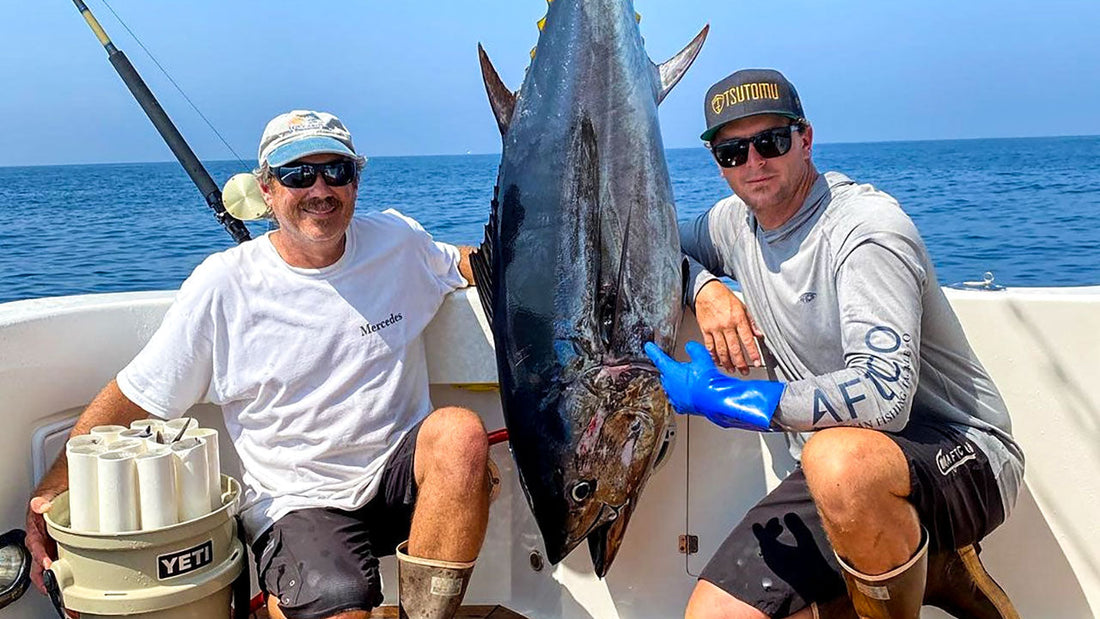
Fish Care 101: 6 Tips for the Freshest Fish at Home
Words by Doug Olander

Catch-and-release fishing is popular, but nothing tops cooking your catch at home. The process from your initial pursuit to fresh fish on your dinner table is crucial. How you deck a fish significantly impacts its quality and flavor. Instead of unhooking fish and throwing them into a fish box or cooler, don’t let them suffer slowly, and follow these six tips for the freshest fish at home.
1. Get Your Fish on Board
Fish care starts as soon as your catch hits the deck. From the second your catch hits the deck, its life is in your hands, and the quality of your catch depends on how you handle it. Gaffing a fish is a classic way to get a fish onboard. AFTCO has been making gaffs in its US-based warehouse for many years, with sizes ranging from three to eight feet and several hook options. Check out our blog here to learn more about gaffs and how to use them.
Although gaffing fish is the easiest and most common way to get fish on board, it creates a large hole in your catch that introduces bacteria. Gaffing also stresses the fish out and can cause it to secrete stress hormones, making it less firm and more likely to spoil. Due to these reasons, opt for using a landing net or grabbing your fish with your hands.
Unfortunately, these options are not always possible, especially if you’re a saltwater angler bringing in a 500-pound Bluefin tuna. Consider using a landing net to cradle a fish for smaller saltwater and freshwater species. Landing nets make it difficult for fish to escape without stressing them out. Grabbing by hand is the best method, but it can give your catch a chance to escape, and anglers can easily cut themselves on sharp spines. To avoid this, have a good pair of fishing gloves close by, like the AFTCO Utility Gloves or Release Gloves. Gloves protect anglers’ hands from cuts and help them tightly grip their slippery catch to help bring the fish on board. If you can grab your catch by hand or use a landing net, these methods will give you the freshest fish possible.
2. Kill Your Fish
No matter your usual kill method, it’s essential to do it immediately after pulling them onto the boat. First and foremost, it’s a humane and responsible thing to do as an angler. Tossing fish into a fish box to slowly suffocate is brutal, and the stress degrades the quality of the fish. Letting your catch suffer is a loss either way because as the fish suffers, so does its flavor. Also, the next step, bleeding, is much easier to accomplish when your catch is not flopping wildly on deck.

Using a fish bat is the most common way to dispatch a fish. The AFTCO fish bat is corrosion-proof, floats, and has a safety lanyard attached. Besides a fish bat, anglers can use a fish billy to administer a few hits on top of the head, which is typically enough to stun the fish. If you prefer to stun your catch, keep a fish billy within reach.
The superior method for dispatching a fish is called Ike Jime. It's a Japanese method that is quick, humane, and keeps the fish's flavor in top condition. With the Ike Jime method, anglers use a brain spike to euthanize fish. This method prevents stress hormones from going to the rest of its body, which helps maintain the fish's quality. To learn more about Ike Jime and how to perform it correctly, click here.
3. Bleed Your Fish
The easiest way to guarantee high-quality fillets is to bleed your catch immediately. If you don’t bleed your catch, the fillets it produces will probably be darker in color and have a strong “fishy” flavor. Blood causes bacteria and leads to decay in the fish's flesh. To avoid this, bleed your catch immediately to keep your fillets lighter in color with no fishy flavor.

Ryan Griffin making the cut.
To start bleeding your fish, slice through the narrow area at the throat between the gills to cut the vein to the heart. Or anglers can make a vertical cut behind the gills instead. After cutting, it’s best to bleed your fish in water, either over the side of the boat or in a fish bucket. By doing this, the fish bleeds out faster, and you can avoid keeping blood out of the boat.
4. Cool Your Catch
With your fish prepped, it’s time to start cooling it immediately. “Ice is key,” says Robby Gant, AFTCO’s tackle brand manager. “The more the merrier: We try to bring a pound of ice per pound of fish we think we’ll want to keep,” he says. If you’re after large fish, like tuna, invest in a quality kill bag if your boat doesn’t have a large enough insulated fish locker. Gant says a cheap kill bag won’t keep your ice solid for long.
Something else important to note is that if you’re fishing in coastal waters, add saltwater to the ice. Saltwater freezes several degrees colder than freshwater. “The saltwater, along with the ice, makes an unbelievably cold slurry to surround your fish and give you the best product,” Gant says.

Prime tuna specimen enjoying a post mortem ice bath. Photo: Ryan Griffin
5. Freeze Your Fish
If you have enough fish to freeze at home, a vacuum sealer can keep your catch fresh for months. Vacuum sealing is critical because it removes all the air, which causes freezer burn and deteriorates the quality of your catch. If you don’t have a vacuum sealer, Gant suggests placing 1-2 servings of your fish into a heavy-duty Ziploc or similar plastic storage bag. Then, zip the bag and leave one of the top corners open. After that, grab a bowl or bucket of water and completely submerge your fish fillets while keeping the top corner open above the water’s surface. This process forces the air out of the bag, like a traditional vacuum sealer. Once this is complete, zip the rest of the bag up. Gant says, “If done correctly, once you pull the bag out of the water, the plastic should have formed tightly around the fillets.”

To store fish in the freezer:
- Lay the fish fillets horizontally to keep them straight.
- Freeze one bag at a time until it’s frozen solid. Once the bags are frozen solid, you can stack them on top of each other in the freezer.
- Learn more about vacuum sealers in our Nine Secrets to Vacuum Sealing Fish blog
6. Use A Good Fillet Knife
A high-quality fillet knife means better, cleaner fillets and provides safety and convenience. “I prefer razor-sharp German stainless steel,” says Captain Andy Mezirow, who operates Gray Light Sportfishing out of Seward, Alaska. A fillet knife that’s not razor-sharp creates ragged fillets, wasted meat, and often cut fingers. Captain Mezirow says the AFTCO fillet knives are the best he’s used in his seasoned career. The AFTCO fillet knives have Böker German stainless-steel blades with corrosion resistance and a non-slip handle for a secure grip.
The 10-inch AFTCO knife is Captain Mezirow’s go-to because he uses it for most of his fillet work, particularly salmon. For smaller, thick-skinned, and heavy-boned bottom fish, he’ll use the 8-inch knife. Then, for giant tuna or halibut, he uses the 12-inch knife. For anglers who fillet fish less often, Captain Mezirow recommends using shorter blades because they are easier to control.
Captain Mezirow adds, “I use a diamond steel to sharpen my knives during the season, then send them off to be professionally sharpened in the off-season.”
Ultimately, the proof is in the process. Following these six tips, anglers will reap the rewards of their efforts with a flavor-filled catch months later.

“I work by myself, which means every fish that is kept is iced, bled and ultimately filleted by me. I view care and processing of the catch to be another aspect of judging the quality of a guide. There’s no point in taking fishermen out to kill a bunch of fish if you don’t care for that catch on board, and then deliver fish-market-quality fillets to the clients. Its all part of the deal.”
- Capt. Andy Mezirow





